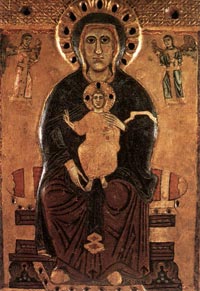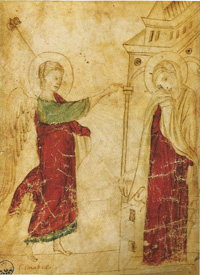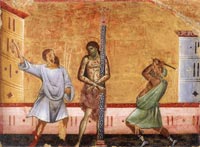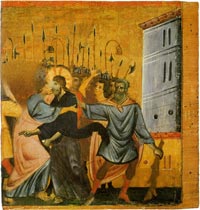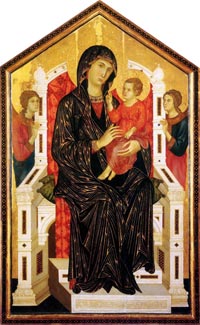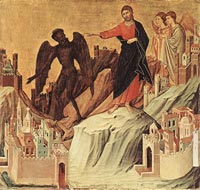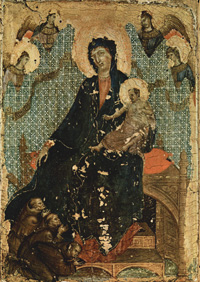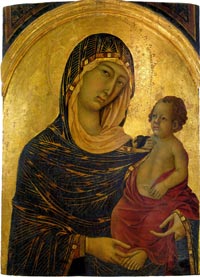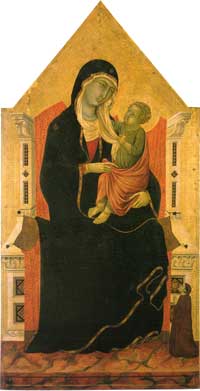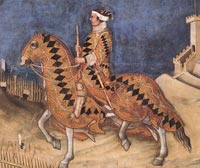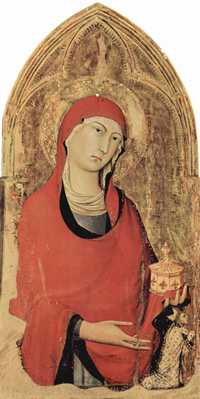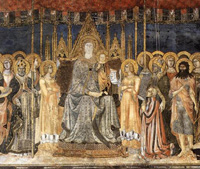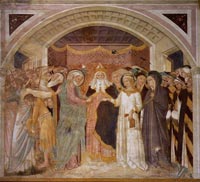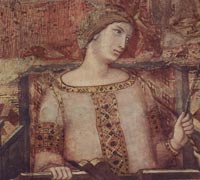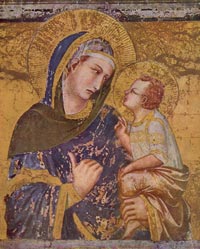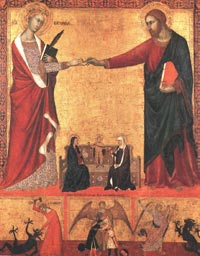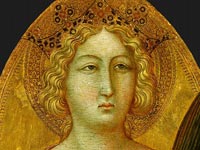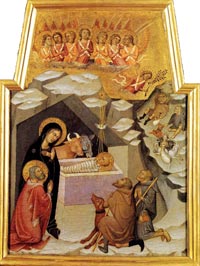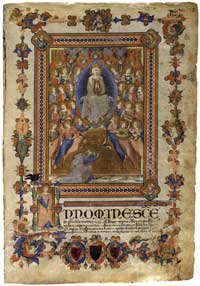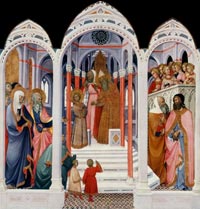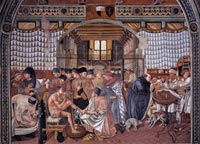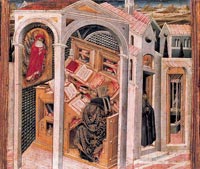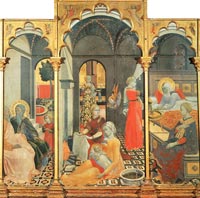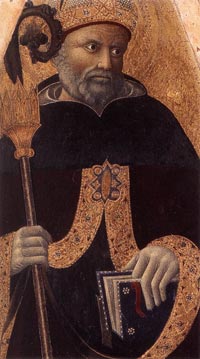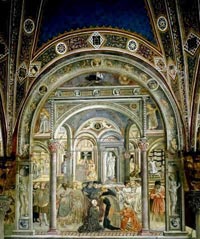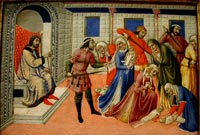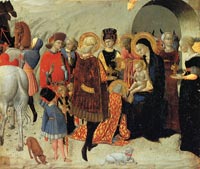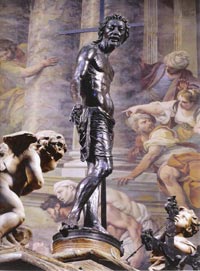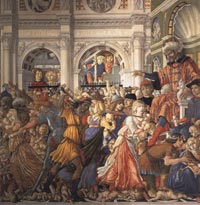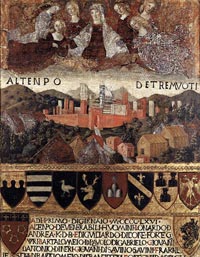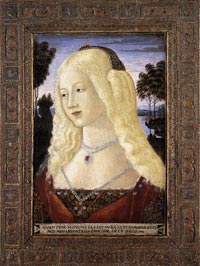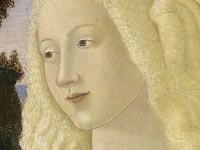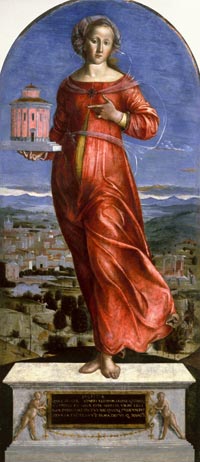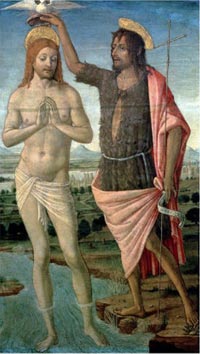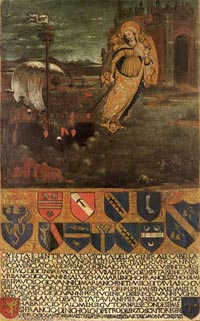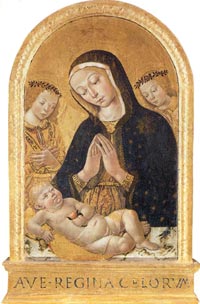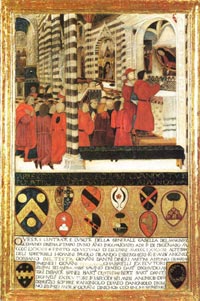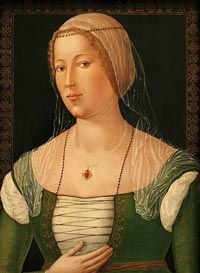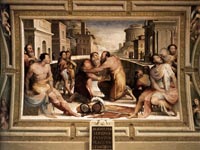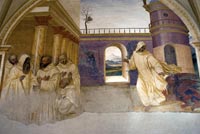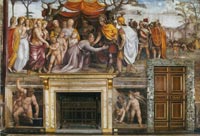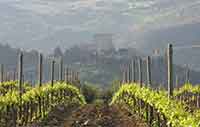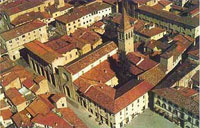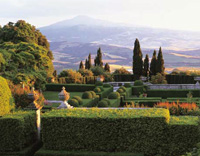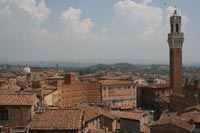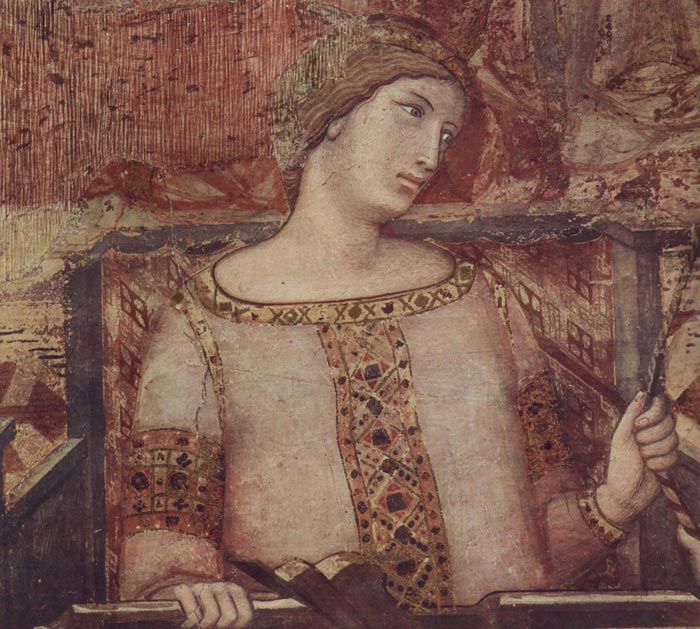 |
Ambrogio Lorenzetti, Allegory of Good Government (detail), Palazzo Pubblico, Siena, 1338-40 |
The Sienese School of painting |
| The first Sienese painter whose name is known to us is Guido da Siena, who was active in the second half of the thirteenth century. This does not mean that there were no native-born painters working in Siena before this time. Indeed, there is a large group of panel paintings by anonymous artists which attest to the fact that early in the thirteenth century, if not actually in the late twelfth cenutry, Siena already had a lively tradition of painting, but its style was not yet distinct from that of other centers in Tuscany and the Umbrian-Roman regions. The Sienese School of painting flourished in Siena between the 13th and 15th centuries and for a time rivaled Florence, though it was more conservative, being inclined towards the decorative beauty and elegant grace of late Gothic art. [1] Its most important representatives include Duccio, whose work shows Byzantine influence, his pupil Simone Martini, Pietro and Ambrogio Lorenzetti, Domenico and Taddeo di Bartolo, Sassetta and Matteo di Giovanni. Unlike the naturalistic Florentine art, there is a mystical streak in Sienese art, characterized by a common focus on miraculous events, with less attention to proportions, distortions of time and place, and often dreamlike coloration. Siena was not backward-looking, as so often alleged. Its artistic growth was sufficient to attract the likes of Donatello — who came in old age and worked for several years, profoundly influencing the development of local art — Signorelli, Pintoricchio, and, in his wake, even Rafaello, who came to work with him on the Piccolomini Library frescoes in 1503. In the 16th century the Mannerists Beccafumi and Il Sodoma worked there. The economic and political decline of Siena by the 16th century, and its eventual subjugation by Florence, largely checked the development of Sienese painting, although it also meant that a good proportion of Sienese works in churches and public buildings were not discarded or destroyed by new paintings or rebuilding. Siena remains a remarkably well-preserved Italian late-Medieval town. |
In the thirteenth and early fourteenth centuries, a greater emphasis on human experience and perceptions prompted artists of many kinds to begin "speaking in the vernacular." Poets in Sicily invented and perfected the sonnet, and Dante wrote the Divine Comedy — not in Latin but Italian. Also for the first time, sermons were given in native Italian dialects by members of influential new religious orders, particularly the Franciscans and Dominicans, who left the shelter of monasteries to preach in cities and towns. Religion focused increasingly on human and humane concerns. The simple virtues of the early Franciscans — who renounced worldly possessions and identified strongly with Christ and his suffering — helped to shift emphasis onto Christ's human nature and to demand of religious art a new and closer identification with people's experience. Artists responded by enhancing the sense of particular time and place with detailed settings familiar to their viewers, by expanding the range of gesture and emotion, and by embroidering their narratives with anecdotal details. Early Italian artists adopted the techniques and traditions of Byzantine art: the gold backgrounds and timeless figures that give spiritual force to icons. But increasingly they began to convey a physical as well as a spiritual reality. The Renaissance celebration of freedom of self-determination had a profound effect on the visual arts. Whereas medieval art focused on otherworldly truths, Renaissance art was nurtured on the principles of humanism, which also paid tribute to visible reality. Greek and Latin learning emboldened thinkers to place the human being at the center of their world view. Interest in the classical past did not impede Christian devotion; religious art remained dominant, and secular art forms emerged also. Tuscany was the cradle for the new humanist concerns. While Duccio's fourteenth-century Maestà altarpice for Siena Cathedral owes much of its linear and decorative style to his Byzantine predecessors, certain elements in it derive from the painter's direct observation of nature. As religious emphasis shifted to Christ's human experience, closer identification with people's experience was required of art. Artists responded with details familiar in the lives of their viewers. The decline of Sienese painting from the second half of the 14th century is so splendidly described by Bernhard Berenson in his essay The Central Italian Painters (first published in 1897): 'With the death of the Lorenzetti, the Sienese school of painting fell into a decline from which it never seriously rallied. It had moments of hopefulness and hours of hectic beauty, but never again did it receive that replenishment of force without which art is doomed to dwindle away. Barna, Bartolo di Fredi, and Taddeo di Bartolo at times catch a glow from the splendour of Simone Martini and the Lorenzetti; and Domenico di Bartolo made an uncouth attempt to breathe new life into the school, to replenish it by introducing the shapes and attitudes which the great Florentines had just saved out of chaos and for ever fixed. But as he felt not at all the real significance of these new forms and new gestures (as serving to render either tactile values or movement), his fellows in craft and town had the taste to prefer, to the mock-heroics of a misunderstood naturalism, the unsubstantial but lovely shapes of their long-hallowed tradition. The ever winsome Sassetta lived and painted as if Florence were not forty but forty millions of miles away, as if Masaccio and Donatello, Uccello and Castagno had not yet deserted the limbo of unborn babes. And he has made us the richer by many works of rich, decorative beauty, and by that scene of visionary splendour, the Chantilly 'Marriage of the Seraphic St. Francis'. |
|||||||||||||||||
|
|||||||||||||||||
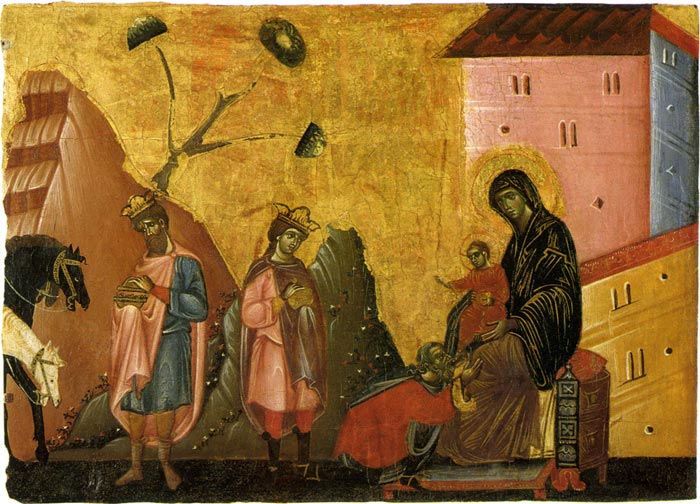 |
|||||||||||||||||
Guido da Siena, Adoration of the Magi, about 1275-1280, Altenburg, Lindenau-Museum |
|||||||||||||||||
|
|
|||||||||||||||||
| Master of Tressa |
|||||||||||||||||
This Byzantine icon was on the high altar of the Cathedral in Siena in the 13th century. The painter of this picture is referred to as the Master of Tressa. the namesake Madonna of the Big Eyes, which got nudged off the cathedral's high altar by Duccio's Maestà, was painted in the 1220s by the "Maestro di Tressa." |
|||||||||||||||||
| Coppo di Marcovaldo |
|||||||||||||||||
Coppo di Marcovaldo (1225, Firenze - 1274, Siena) was one of the earliest about whom there is a body of documented knowledge. He was born in Florence, and is mentioned as active in Pistoia in 1265, where he frescoed the St. James Chapel in the cathedral.
|
|||||||||||||||||
| Vigoroso da Siena |
|||||||||||||||||
|
|||||||||||||||||
| Guido of Siena |
|||||||||||||||||
Guido of Siena, also known as Guido di Graziano, was an Italian Byzantine style painter of the 13th century. He may have made significant advances in the techniques of painting, much as Cimabue much later accomplished. However, there is some debate about this. Guido is primarily known for a painting which is now split into several pieces. The church of S. Domenico in Siena contains a large painting of the Virgin and Child Enthroned with six angels above. The Benedictine convent of the same city has a triangular pinnacle representing the Saviour in benediction, with two angels. This was once a portion of the same composition, which was originally a triptych. The principal section of this picture has a rhymed Latin inscription, giving the painter's name as Guido de Senis, with the date 1221. However, this may not be genuine, and the date may really read as 1281. There is nothing particular to distinguish this painting from other work of the same period except that the heads of the Virgin and Child are much superior – in natural character and graceful dignity – to anything painted before Cimabue. As a result, there is some dispute as to whether these heads are really the work of a man who painted in 1221, long before Cimabue. Crowe and Cavalcaselle have proposed that the heads were repainted in the 14th century, perhaps by Ugolino da Siena. If Crowe and Cavalcaselle are right, Cimabue maintains his claim to the advancement of the art. Beyond this, little is known of Guido da Siena. A picture in the Academy of Siena is attributed to him (a half-figure of the Virgin and Child, with two angels), which dates (probably) between 1250 and 1300. Also in the church of S. Bernardino in the same city is a Madonna dated 1262. Milanesi has proposed that this is by Guido Graziani, although there is no record of Graziani earlier than 1278, when he is mentioned as the painter of a banner. Guido da Siena appears always to have painted on panel, not in fresco on the wall. It is possible that he was a pupil of Pietrolino, and the master of Diotisalvi, Mino da Turrita and Berlinghieri da Lucca. |
|
||||||||||||||||
| Rinaldo da Siena |
|||||||||||||||||
| Rinaldo da Siena, a painter and illuminator, is documented in Siena in 1274 and then again in 1278. He was a follower of the artist Cimabue, who was influenced by contemporary Byzantine painting, and a forerunner of Duccio, celebrated for the expressive emotional character of his work. His few known works include a painted wood crucifix in the Museo Civico, San Gimignano, a manuscript of The Book of the Reign of Princes(Paris, Bibliotheque nàtionale, Paris), a manuscript of Vegezio's Mulomedicina (Florence, Biblioteca Laurenziana) and frescoes in the Crypt of Siena Cathedral. | |||||||||||||||||
|
|
|||||||||||||||||
| Master of Badia a Isola |
|||||||||||||||||
The Master of Badia a Isola was active at the end of the 13th century in the small circle of Duccio di Buoninsegna, and introduced certain important innovations in his work, thanks to contact with the works of Cimabue and of the young Giotto. His name, Master of Badia a Isola, is taken from a depiction of the Madonna and Child that hangs in the Badia dei Santi Salvatore e Cirino in Abbadia a Isola. A number of critics agree in grouping a Virgin and Child (Siena, Pin. N., 593), a polyptych that once contained a St Paul, a St John the Evangelist and a St Peter (South Hadley, MA, Mount Holyoke Coll. A. Mus.), a St John the Baptist (Cologne, Wallraf-Richartz-Mus., 608), a Virgin and Child (Utrecht, Catharijneconvent), a Redeemer and four Angels (untraced) and a Virgin and Child Enthroned with Four Angels (Venice, Fond. Cini), but other attributions are widely debated. |
|||||||||||||||||
No other city outside Florence produced a comparably great school of painting, culminating in the figures of Duccio di Buoninsegna (active by 1278, died 1318), Simone Martini (active by 1315, died 1344), and the brothers Pietro and Ambrogio Lorenzetti (active 1320–44, 1319–47, respectively). Duccio may be considered the father of Sienese painting and is, together with Giotto, one of the founders of Western art. His paintings introduce a lyrical note and a refined sense of color into European painting, and he was an usurpassed story teller, or narrative artist. Duccio’s early paintings are still strongly indebted to the visual and iconographic traditions we associate with Byzantine art. He was in touch with the two leading Florentine painters, Cimabue and Giotto, and also knew northern Gothic art. Together with Giotto, his later works set the stage for the early Renaissance by endowing figures and objects with a physical and emotional dimension that, in retrospect, made earlier paintings seem mere images. Art in Tuscany | Duccio di Buoninsegna |
|||||||||||||||||
Segna di Bonaventura, also known as Segna de Bonaventura, and as Segna di Buonaventura, was an Italian painter of the Sienese School. He was active from about 1298 to 1331. In 1306 he painted a panel for the office of the Biccherna in the Palazzo Pubblico in Siena. In 1317 he painted an altar panel for the convent of Lecceto (near Siena). In 1319 he repaired a figure of the Virgin in the Palazzo Pubblico. In 1321 he painted a panel for the Palazzo Pubblico. Segna di Bonaventura’s sons Niccolò di Segna and Francesco di Segna di Bonaventura were also painter of the Sienese School.
|
|||||||||||||||||
| Ugolino di Nero |
|||||||||||||||||
| Ugolino di Nero, also known as Ugolino da Siena, was probably a pupil of Duccio and perhaps his most faithful follower. He is documented in Siena from 1317 to 1327 and appears to have been an important artist with a successful workshop. None of the documents mentions works of art, however, and it has proved difficult to reconstruct his career. His principal surviving documented work, a polyptych from Santa Croce, Florence, dating from 1325-30, is now dispersed. Ugolino was influenced not just by Giotto, but by other Sienese artists following in Duccio's footsteps, such as Simone Martini and Pietro Lorenzetti. Both of these were linked to the papal court at Avignon, where the Italian style mixed with French Gothic. The early Italian High Altar by Ugolino di Nerio for Santa Croce, the great Franciscan church of Florence, is well-documented. With at least thirty-five sections in all, this massive altar was painted and erected c. 1325-30. These panels recall Duccio's sense of style and organization, as Ugolino was still working with Byzantine line and colour. The altar was dismantled shortly after 1566 and moved to the church's dormitory. By the 1830s, most of its panel had been sold. Now the surviving panels are scattered among museums and private collections. Art in Tuscany | Ugolino di Nerio |
|||||||||||||||||
| Niccolo di Segna |
|||||||||||||||||
Niccolò di Segna began his career in the workshop of his father, Segna di Buonaventura. He followed the style of Duccio with a greater rigidity of the forms. He was also influenced by Simone Martini as seen in the Crucifixion (1345, Pinacoteca Nazionale, Siena) and in the frescoes attributed to him (S. Colomba a Monteriggioni near Siena). The Duomo in Sansepolcro contains a gilded polyptych of the Resurrection (14th century), attributed to Niccolo di Segna. The central figure of Christ stands in a pose so similar to Piero della Francesca's Ressurection in the Museo Civico, that many feel della Francesca must have studied this first. Art in Tuscany | Niccolò di Segna |
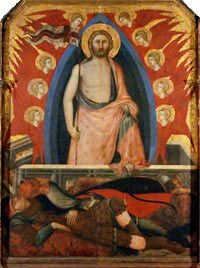 Resurrection by Niccolò di Segna |
||||||||||||||||
| Master of Monte Oliveto |
|||||||||||||||||
| The Master of Monte Oliveto has traditionally been thought of as a close follower of Duccio, and several scholars have suggested that he actually worked for some time in the shop of the great master, placing his years of activity from about 1300 to about 1320. However, most of these observations rely heavily on iconographical comparisons between the Master's and Duccio's works. The Master of Monte Oliveto, who worked primarily on small objects for personal devotion, such as tabernacles and triptychs (18.117.1) (no large altarpieces are known to have been painted by him). The Master's style is often recognizable by the heavy white highlights he uses to indicate lips, noses, and other facial features. His body of work reveals an artist who probably catered to a largely provincial clientele, which was perhaps less rigorous in its demands for the most up-to-date painterly trends. By attempting to understand his oeuvre this way instead of forcing him into the ranks of Duccio's closest followers, it becomes much easier to understand the chronological arrangement of the Master's paintings. Looked at this way, the Master of Monte Oliveto's work is far closer to that of one of Duccio's earliest and most well-known pupils, Segna di Buonaventura. Art in Tuscany | Master of Monte Oliveto |
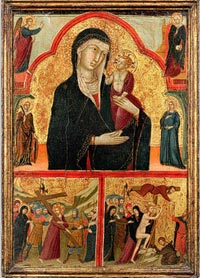 Master of Monte Oliveto, Tabernacle Center with the Madonna and Child, Annunciation, Via Crucis, and Christ Mounting the Cross, ca. 1325, Alana Collection, Delaware |
||||||||||||||||
Simone Martini developed the lyrical vein in Duccio's art. An artist of incomparable refinement and descriptive abilities, he became one of the most sought-after painters of the day, dying at the papal court in Avignon, France, and famously praised by the great poet Petrarch. The richly tooled surfaces of his paintings and their elegant naturalism became the basis of courtly art from Paris to Prague. |
|||||||||||||||||
Lippo Memmi |
|||||||||||||||||
Lippo Memmi (c. 1291 – 1356) was an Italian painter from Siena. He was the foremost follower of Simone Martini, who was his brother-in-law. Together with Martini, in 1333 he painted one of the masterworks of the International Gothic, the Annunciation for the Sienese church of Sant'Ansano (now in the Uffizi). He was one of the artists who worked at the Orvieto Cathedral, for which he finished the Madonna dei Raccomandati. Later he followed Martini at the Papal court in Avignon, where he worked until the mid-14th century. After his return to Siena, Memmi executed several works until his death in 1356. |
|||||||||||||||||
Naddo Ceccarelli
|
|||||||||||||||||
Due to lack of historical or written sources, little is known of Naddo Ceccarelli or his work. Knowledge of his existence is based solely on two paintings signed by him, one of which is dated 1347, one year before the devastating plague. His signature also provides information concerning his origin in Siena. Stylist comparison of the two paintings attributed to Ceccarelli permits the reconstruction of a small oeuvre which places the artist as a direct successor of Simone Martini, one of the grand masters of the Siena School. In 1339 Ceccarelli appears to have accompanied him to the Papal Court in Avignon. Following the death of Simone, Ceccarelli may have returned to Siena. There is little evidence of the innovations of Lorenzetti or Giotto in his works. Ceccarelli remained true to the Siena painting tradition and its representatives Duccio and Simone Martini, whose soft linear painting style he continued. |
|||||||||||||||||
| Lippo Vanni |
|||||||||||||||||
Lippo Vanni (Lippo di Vanni) was an Italian painter and illuminator. He is documented as a painter and illuminator in Siena between 1344 and 1375, and in 1360 and 1373 he took part in the General Council of Siena. The earliest work attributed to him is the illumination of the choirbooks for the Collegiata at San Gimignano (c. 1340-42, San Gimignano, Museo Arte Sacra), in which the supple movement and individuality of figures and scenes already show the expressive quality characteristic of Lippo's later documented work. |
|||||||||||||||||
| Ambrogio Lorenzetti |
|||||||||||||||||
Ambrogio Lorenzetti was active between approximately 1317 to 1348. His elder brother was the painter Pietro Lorenzetti. |
|
||||||||||||||||
| Pietro Lorenzetti |
|||||||||||||||||
Pietro Lorenzetti was active between approximately 1306 and 1345. |
|||||||||||||||||
Barna da Siena |
|||||||||||||||||
Barna (or Berna) da Siena, Italian painter. According to I commentari, written by Lorenzo Ghiberti towards the end of his life, a Sienese painter named Barna painted several works in Tuscany, including many stories from the Old Testament in San Gimignano. Giorgio Vasari, in the first edition of his Vite (1550), listed a number of works by the Sienese painter 'Berna', including frescoed Old Testament scenes in the 'Pieve' of San Gimignano, but in the second edition (1568) he referred only to New Testament scenes in that church, dating them to the very end of Barna's life, apparently to 1381. According to Vasari's brief but vivid life of 'Berna, painter of Siena', the artist was killed in a fall from the scaffolding while painting them. |
|||||||||||||||||
| Ugolino Lorenzetti, also known as Master of S. Pietro a Ovile or Master of the Ovile Madonna was active between 1320 and 1360. | |||||||||||||||||
Bartolomeo Bulgarini |
|||||||||||||||||
Bartolomeo Bulgarini, also known as Bartolomeo di Misser Bolgarino or Bolgarini Many of his paintings were attributed by Berenson to an anonymous master he called 'Ugolino-Lorenzetti', because of the artist's obvious indebtedness to the work of Ugolino di Nerio and Pietro Lorenzetti. A group of paintings that partially overlapped with these was attributed by Dewald to an artist he called the Ovile Master, after a painting formerly in S Pietro a Ovile, Siena. In 1931 Meiss recognized that these works formed the oeuvre of a single artist, and in 1936 he identified this figure as Bartolommeo Bulgarini. |
|||||||||||||||||
Bartolo di Fredi |
|||||||||||||||||
Bartolo di Fredi (c. 1330 – January 26, 1410) was born in Siena. He had a large studio and was one of the most influential painters working in Siena and the surrounding towns in the second half of the fourteenth century. He registered in the Guild of that city in 1355. He had several children, who all died before him, with the exception of Andrea Bartoli. He was the companion of Andrea Vanni from 1353, and helped decorate the Hall of Council at Siena, in 1361. In 1362 he went to San Gimignano, where, by 1356, he had painted the entire side of the left aisle of the Pieve with scenes drawn from the Old Testament. In 1366 the Council of the city of Gimignano ordered a painting, representing Two Monks of the Augustine Order to be placed in the Palazzo Pubblico, in order to commemorate the settlement of some disputes which had long existed between that order and the city. In the early part of 1367 he returned to Siena, and was employed with Giacomo di Mino in the decorations of the cathedral. In 1372 he rose to a position in the government of the city, and was sent to welcome the new Podesta, on his approach to Siena. In 1381 he was himself made a member of the Council, and in 1382 he executed the Descent from the Cross now in the Sacristy of San Francesco, Montalcino. The same church also possesses panels painted by him containing the Baptism of Christ figures of SS. Peter, Paul, and Francis, and five scenes from the life of St. Philip of Montalcino. In 1389, Bartolo, assisted by Luca Thome, painted the altar-piece for the Shoemakers' Company, in the Cathedral, and continued from that year until his death to furnish altar-pieces for the cathedral and other churches of Siena, which have now all disappeared. |
|||||||||||||||||
Andrea Vanni |
|||||||||||||||||
Andrea Vanni (1332-c. 1414) was born in Siena, and in conjunction with Bartolo di Maestro Fredi, began to paint in 1353. As an artist he was a weak imitator of Simone Martini and of Lorenzetti. With his brother Lippo Vanni, Bartolo di Fredi, and Taddeo di Bartolo, he introduced early Sienese art into the fifteenth century. |
|||||||||||||||||
Francesco di Vannuccio |
|||||||||||||||||
Francesco di Vannuccio (documented 1356–1389; died before 1391) was born in Siena. A small body of work has been ascribed to this painter, characterized by an attention to and love of pattern and decoration, a tradition dating back in Siena to Simone Martini. A signed and dated double-sided processional standard of 1380, painted on one side with the Crucifixion and on the other side with a painted glass depiction of the Virgin Enthroned with Saints, in the Gemäldegalerie, Berlin (inv. no. 1062B), has been the basis on which a number of other paintings have been attributed. Most of these are small-scale works, richly finished, which were meant for private devotion, suggesting that Francesco di Vannuccio worked for a discerning and wealthy group of private patrons. The style of the Berlin Crucifixion suggests a connection with a more overtly expressive area of the Sienese tradition and with the late style of Simone Martini in particular. The beetle-browed and distinctly fleshy faces of Francesco's figures, expressive almost to the point of caricature, may ultimately derive from such models as the mourning women of Simone's Entombment (Berlin, Gemäldegal.) or the figures in the Master of the Codex of St George's panels. |
|||||||||||||||||
Jacopo di Mino del Pellicciaio |
|||||||||||||||||
Jacopo di Mino del Pellicciaio, also called Giacomo di Mino, appears to be a follower of Simone Martini. He was the contemporary of Lippo Vanni and Luca Thome, being in 1373 appointed to value one of latter's pictures. His name appears in the Sienese records from 1362 to 1389. In 1367 he aided Bartolo di Maestro Fredi at the Siena cathedral. He is known to have painted book-covers for the Biccherna, and was several times a member of the Grand Council of Siena. He frescoed for the Basilica of San Francesco. |
Coronation of the Virgin of 1340-1350, typical of the smaller Gothic depictions of the subject |
||||||||||||||||
Niccolò di Bonaccorso |
|||||||||||||||||
Niccolò di Bonaccorso was active between 1372 and 1388. Little is know about Bonaccorso, except that he may have been from Prato, and painted in the Sienese style. |
|||||||||||||||||
Niccolo di Ser Sozzo Tegliaccio |
|||||||||||||||||
Niccolo di Ser Sozzo Tegliaccio was an Italian miniaturist and illuminator of a religious codex. The painter was probably the son of an obscure Sienese illuminator, ser Sozzo di Stefano. The superb illustration of the Assumption of the Virgin in the Caleffo Bianco (a register of state documents in the Siena Archive) and the polyptych of the Virgin and Child with Four Saints (Siena, Pinacoteca Nazionale) are signed by Niccol? di ser Sozzo. |
|||||||||||||||||
Luca di Tommè |
|||||||||||||||||
Luca di Tommè was active between 1356 and 1389 in Siena. He was a colleague of Bartolo di Fredi. Luca di Tommè headed a large, prolific workshop and was an influential contributor to the long legacy of Siena's celebrated artistic style, which flourished in the 1300s and 1400s. He was also active in Sienese government. Luca was probably trained by the Lorenzettis, owners of the most prominent workshop in Siena, whose work was distinguished by solid, three-dimensional forms and emotional depth. He probably learned both fresco and panel painting there, but none of his frescoes survive. Another early influence was likely the delicacy and elegant linearity of Simone Martini's work. In 1356 Luca joined Siena's newly founded painters' guild. He worked almost continuously for the Siena Cathedral. Luca's workshop created mostly altarpieces, and he often collaborated with other artists. His artistic output declined after the 1370s, possibly because his civic duties required more time. His style was marked by a growing facility at expressing emotion, relating figures to their settings by developing spatial depth, and a typically Sienese interest in drapery and ornamentation. Although Luca spent most of his working life in Siena, he also may have accepted commissions elsewhere in Tuscany. Behold the Lamb of God, which taketh [away the sin of the world]. These words, inscribed in Latin on the scroll held by Saint John the Baptist, announce the coming of Christ. Standing against a gold background and enclosed in a Gothic trefoil frame, Saint John wears a hair shirt that represents his ascetic life of prayer and penance. Using carefully curved brushstrokes, Luca di Tommè described the woolly texture of Saint John's shirt and the unruly curliness of his hair and beard. Patterned punch marks form the decorative halo around the saint's head. The Old Testament prophets Elijah and David, who predicted the coming of the Messiah, occupy the upper corners of the frame. This panel was once part of an altarpiece, possibly for a church in Siena. |
Luca di Tommè Italian, Siena, late 1300s Tempera on panel |
||||||||||||||||
Taddeo di Bartolo (1362 or 1363 – August 26, 1422), also known as Taddeo Bartoli, was a painter of the Sienese School during the early Renaissance. He is among the artists profiled in Vasari's Le Vite delle più eccellenti pittori, scultori, ed architettori. Vasari claims he is the uncle of Domenico di Bartolo. |
|||||||||||||||||
Andrea di Bartolo |
|||||||||||||||||
Andrea di Bartolo (b. 1360/70, Siena, d. 1428, Siena) was the son of Bartolo di Fredi. He worked on many important commissions with his father (e.g. the Coronation of the Virgin polyptych, Montalcino). Later he secured a number of commissions independently of his father (e.g. St Catherine of Siena, Murano), and passed on his skills to his sons, Giovanni and Ansano. He was influenced by the great Sienese masters of the 14th century, such as Duccio and Simone Martini. He worked with Luca di Tommè. Andrea di Bartolo ran a reliable workshop and was commissioned in 1394 to turn out a large number of more-or-less identical Virgins of Humility - one for each nun's cell of a newly built Dominican convent in Venice. |
|||||||||||||||||
| Paolo di Giovanni Fei |
|||||||||||||||||
Paolo di Giovanni Fei (c. 1345 – c. 1411) came to Siena from San Quirico, Castelvecchio, held public positions in Siena from 1369 and was first mentioned in the Sienese register of painters in 1389. His earliest signed and dated work is of 1381. He appears among the documents of the Duomo di Siena, 1395-1410, and is assumed to have died shortly thereafter. |
|||||||||||||||||
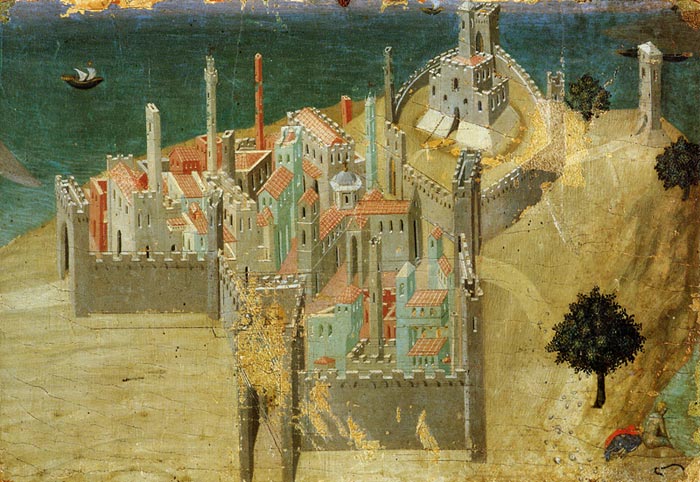 |
|||||||||||||||||
Sassetta (Stefano di Giovanni), (c.1340), Pinacoteca Nazionale, Siena [2] |
|||||||||||||||||
| Lorenzo Monaco (Piero di Giovanni) |
|||||||||||||||||
| He as born Piero di Giovanni in Siena. Little is known about his youth years, apart from the fact that he apprenticed in Florence. He was influenced by Giotto and his followers Spinello Aretino and Agnolo Gaddi. In 1390 joined the Camaldolese monastery of Santa Maria degli Angeli. He was thenceforth generally known as Lorenzo Monaco (English: "Lawrence the Monk"). In the 1390s he executed three panels of the Biblioteca Laurenziana for his convent. Starting from around 1404 his works show the influence of the International Gothic, of Lorenzo Ghiberti's earliest works and of Gherardo Starnina. From this period is the Pietà in the Gallerie dell'Accademia in Florence. His works, often over a gilted background, showed in general a spiritual value, and usually did not feature profane elements. In 1414 he painted the Coronation of the Virgin (now at the Uffizi), characterized by a great number of saints and brilliant colors. In the late part of his life, Lorenzo did not accept the early Renaissance innovations introduced by artists such as Masaccio and Brunelleschi. This is visible in the Adoration of the Magi of 1420-1422, where the now widespread geometrical perspective is totally absent. Lorenzo's works remained popular in the 1420, as testified by the numerous commissions he received, such as the Stories of the Virgin in the Bartolini Salimbeni Chapel of Santa Trinita, one of his few frescoes. Art in Tuscany | Lorenzo Monaco
|
|||||||||||||||||
Benedetto di Bindo (Castiglione di Valdorcia, 1380-85 - Perugia, 1417) may have been a pupil of Paolo di Giovanni Fei and was influenced by Taddeo di Bartolo in his early works. However, the strongest influence on his art was Simone Martini. He is first recorded on 20 November 1409, when he was paid by the Opera del Duomo, Siena. He had overall responsibility for the fresco decoration of the three chapels in the sacristy of Siena Cathedral (1411-1412), one the most prestigious commissions in Siena at that date. There he worked with a group of painters sometimes called the Masters of the Sacristy of Siena Cathedral. His work has a lively narrative style and uses forceful characterization in such scenes as the Apparition of St Michael on Castel S Angelo in the chapel of the Reliquary. Between November 1415 and November 1416 he painted the frescoes in the chapel of SS Catherine and Peter Martyr in S Domenico, Perugia. Other works attributed to him include the fresco of the Assumption of the Virgin (Siena, San Niccolò al Carmine (Santa Maria del Carmine)), the Virgin and Child with SS Andrea and Onofrio (Siena, Pinacoteca Nazionale). |
|||||||||||||||||
| Domenico di Bartolo |
|||||||||||||||||
Domenico di Bartolo was born in Asciano. According to Vasari, he was a nephew of Taddeo di Bartolo. He was employed by Vecchietta in the masterpiece fresco The Care of the Sick in the Pellegrinaio (Pilgrim's Hall) of the Ospedale di Santa Maria della Scala in Siena [1]. It portrays wealthy donors visiting the hospital to men washing the ill, and a fatty friar hearing confession. In 1434, he also painted a fresco panel of Emperor Sigismund Enthroned for the Siena Cathedral. |
|||||||||||||||||
Giovanni di Paolo di Grazia (1399 or 1407 – 1472) was an Italian painter, working primarily in Siena. His middle name was Harut after his great Armenian grandfather. He may have apprenticed with Taddeo di Bartolo, becoming a prolific painter and illustrator of manuscripts, including Dante's texts. He was one of the most important painters of the 15th century Sienese school. His early works show the influence of earlier Sienese masters, but his later style was more individual, characterized by cold, harsh colours and elongated forms. His style also took on the influence of International Gothic artists such as Gentile da Fabriano. Many of his works have an unusual dreamlike atmosphere, such as the surrealistic Miracle of St. Nicholas of Tolentino painted about 1455 and now housed in the Philadelphia Museum of Art, while his last works, particularly Last Judgment, Heaven, and Hell from about 1465 and Assumption painted in 1475, both at Pinacoteca, Siena, are grotesque treatments of their lofty subjects. Giovanni's reputation declined after his death but was revived in the 20th century. Art in Tuscany | Giovanni di Paolo |
|||||||||||||||||
Gregorio di Cecco |
|||||||||||||||||
Gregorio di Cecco (sometimes Gregorio di Cecco da Lucca or Gregorio da Lucca di Cecco) was a painter of the Sienese School during the early Renaissance. He was born in Sienna around 1390 and died before 1424. In 1418, he was paid for painting a cover for Sienese public records (known as a Biccherna panel). Gregorio di Cecco di Luca was greatly influenced by Taddeo di Bartolo. In 1420, he signed an altarpiece with Taddeo in the Marescotti chapel of the church of Sant’Agostino in Siena. He became Taddeo’s adoptive son and heir in 1422. In 1421, Gregorio was part of the commission overseeing the construction of the church and loggia of San Paolo in Siena. His only surviving signed work is the ‘Madonna of Humility’ (Museo dell’Opera del Duomo, Siena) dated 1423. The polyptych of the Madonna of Humility with SS Augustine, John the Baptist, Peter and Paul (Siena, Mus. Opera Duomo), signed and dated 1423, was made for Siena Cathedral and is Gregorio's only securely attributed work. Although the figure style and decorative elements owe much to Taddeo di Bartolo, Gregorio's style is more refined, brittle and elegant and his colour more delicate and clear than his master's. |
|||||||||||||||||
Martino di Bartolomeo |
|||||||||||||||||
Martino di Bartolomeo or Martino di Bartolomeo di Biago was amanuscript illuminator active between 1389 and 1434. He was one of his generation's principal painters of the Sienese School. From specific aspects of his early style, he is believed to have trained in the studio of Taddeo di Bartolo. As a young man Martino collaborated with Giovanni di Pietro da Napoli in Pisa. The fresco cycle in the church of San Giovanni Battista di Cascina, outside Pisa, bears Martino’s signature, and the date 1398. He returned permanently to Siena in 1405. There he painted several prominent fresco cycles in the Duomo and the Palazzo Pubblico. Further official commissions for altarpieces and for polychromy of sculptures attest to his versatility and to his prestige as one of the city’s official artists. Martino's early activity as an illuminator of manuscripts is based on Luciano Bellosi's recognition of his hand in the set of choirbooks commissioned for the cathedral of Lucca by its bishop, Niccolò Guinigi, in 1394. When he contracted with the Collegiata of San Gimignano for the polychromy of the carved wooden Annunciation in 1420, the sculptor, Jacopo della Quercia, stood guarantor. Jacopo's father, Pietro di Angiolo, worked in Martino's shop. |
|||||||||||||||||
| The Master of the Osservanza, also known as the Osservanza Master and as the Master of Osservanza, is the name given to an Italian painter of the Sienese School active about 1430 to 1450. The Italian scholar, Roberto Longhi, recognized that two triptychs formerly attributed to Stefano di Giovanni (il Sassetta), were the work of another hand, now generally referred to as the Master of the Osservanza Triptych. The Virgin and Child with St. Jerome and St. Ambrose (Basilica dell'Osservanza, Siena) and the Birth of the Virgin (Museo d'Arte Sacra, Asciano) are both stylisticly similar to the work of Stefano di Giovanni, but have a narrative expression that is characteristic of Late Gothic painting. Longhi observed that another group of paintings was closely related to these works and appeared to be by the same hand. These included the predella of the Osservanza Altarpiece (Pinacoteca Nazionale, Siena), a predella of St. Bartholomew (Pinacoteca Nazionale, Siena), Scenes of the Passion (Vatican Museums, Philadelphia Museum of Art, and Fogg Art Museum), the Resurrection (Detroit Institute of Arts), and Scenes from the Life of St. Anthony Abbot (panels in the National Gallery of Art, Washington D. C., the Metropolitan Museum of Art, and Museum Wiesbaden, Germany). Additionally, the full-length painting of St. Anthony Abbot in the Louvre appears to be from another altarpiece by the same master. Art in Tuscany | The Master of the Osservanza |
|||||||||||||||||
Pietro di Giovanni d'Ambrogio |
|||||||||||||||||
In a period during which commissions to Sienese painters often demanded adherence to 14th-century precedents, Pietro di Giovanni produced some of the most individual and imaginative solutions, combining local tradition with elements of progressive Florentine style. A member of the Sienese painters' guild in 1428, he had probably trained with Sassetta, whose influence on him was fundamental. Only the last ten years of his brief career are documented. The Saint Augustin panel belonged to an altarpiece, now dismembered. According to the reconstruction accepted by many scholars, the altarpiece consisted of a Virgin and Child in the centre (Brooklyn Museum, New York), St Augustin (Lindenau-Museum, Altenburg) at the left, and probably St Nicholas (lost) at the right. The three predella panels are the Departure of St Augustin (Staatliche Museen, Berlin), the Entry of Christ to Jerusalem (Pinacoteca Stuard, Parma), and the Birth of St Nicholas (Kunstmuseum, Basel). |
|||||||||||||||||
Priamo della Quercia |
|||||||||||||||||
The Ospedale di Santa Maria della Scala, one of Europe’s oldest hospitals, is situated in Siena, in front of the Duomo. The current museum complex of Santa Maria della Scala, was one of the first European hospitals expressly built to accommodate pilgrims traveling along the Via Francigena, and support the poor and abandoned children. Many great Sienese artists worked on the arrangement of the hospital, how today testifies the Pellegrinaio, with 15th and 16th century frescoes by Domenico di Bartolo, Lorenzo Vecchietta, Giovanni Raffaele Navesi and Priamo della Quercia). The iconographic programme was conceived by rector Giovanni di Francesco Buzzichelli (1434–1444), who wanted to mark a significant change in a strongly humanistic sense, creating new compositions governed by a strict perspective, revolutionary for that time. The reference model was no longer based on religious fresco cycles on many registers, but on profane compositions that illustrated mostly cycles of chivalry or in any case, ‘civil’ histories on the walls of the representation halls of private houses or in the halls of the public buildings. This revision according to the Renaissance models was aimed at releasing the subjects of the frescoes from the religious themes and concentrate the attention on the illustration of lay myths of the foundation of the institution or on the realistic representation of the acts and works of piety that marked the daily life of the hospital. Priamo della Quercia, The Investiture of the Rector by Blessed Agostino Novello (1442). This episode represents the investiture of the Hospital Rector by Blessed Agostino Novello who died in 1309 and who was traditionally considered to be the author of the first Statute of Santa Maria della Scala, drawn up in 1305. In reality the Hospital had already been electing its Rectors for many years, so this painting is to be considered as purely symbolic and aimed at demonstrating the importance of this famous Blessed Sienese who was linked to the Hospital and who became immediately very popular. This fresco by Priamo della Quercia, brother of the famous sculptor Jacopo, is one of the few known works by this artist, and it is considered to be the most mediocre of the cycle of the Pellegrinaio (Pilgrims' Hall). The artist in fact tries to adapt his old style to the Renaissance innovations of Domenico di Bartolo and Lorenzo Vecchietta. The scene of the investiture takes place in front of the Cathedral – clearly seen in the background – under a Renaissance Loggia where there is not only the Rector who has been invested with an ample mantle but also another person on the left, richly dressed, who could be either the Emperor Sigismondo who stayed in Siena in 1432 or, more probably the Greek Emperor Giovanni Paleologo, who participated with his followers at the Council of Florence in 1439. Art in Tuscany | Ospedale di Santa Maria della Scala |
|||||||||||||||||
Sano di Pietro |
|||||||||||||||||
Sano di Pietro (1406–1481) was an early Renaissance painter and miniaturist from Siena. He apprenticed under Sassetta and Giovanni di Paolo.
No works by Sano are known before 1443. Sano di Pietro's paintings are housed in the National Gallery and the Cathedral Museum of Siena, the Pinacoteca Vaticana, the Brooklyn Museum of Art, the Lindenau Museum of Altenburg and the Diocesan Museum of Pienza. The panels The Massacre of the Innocents, The Adoration of the Magi, and two others probably formed the predella of an altarpiece, probably that of the "Purification of the Virgin" formerly in the cathedral of Massa Marittima. The pictures, from about 1470, are typical of Sano's popular, conservative approach to painting, appreciated by the Franciscan order. Art in Tuscany | Sano di Pietro Art in Tuscany | The Adoration of the Magi Art in Tuscany | The Massacre of the Innocents |
|||||||||||||||||
Sassetta (Stefano di Giovanni) |
|||||||||||||||||
Known as Sassetta since the 18th century, Stefano di Giovanni was the most important artist in 15th century Siena, where he probably trained with Benedetto di Bindo and where he was inscribed with the guild of painters before 1428. His first documented work was an altarpiece for the Arte della Lana (guild of wool merchants) in 1423-6, while his masterpiece was the double-sided altarpiece for San Francesco, Borgo San Sepolcro 1437-1444. |
|||||||||||||||||
Francesco di Giorgio e di Lorenzo (1412 – June 6, 1480), known as Vecchietta or Lorenzo di Pietro, was an Italian Sienese School painter, sculptor, goldsmith and architect of the Renaissance. Vecchietta was born in Castiglione d'Orcia, and lived in Siena. Much of his work may be found there, particularly at the Hospital of Santa Maria della Scala, lending him yet another name: pittor dello spedale (or "painter of the hospital"). |
|||||||||||||||||
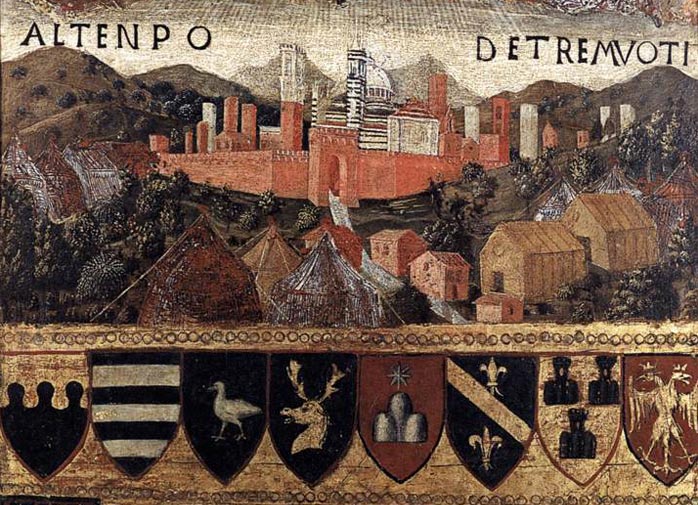 |
|||||||||||||||||
Francesco di Giorgio Martini, Madonna del Terremoto, detail, 1467, Archivo di Stato, Siena |
|||||||||||||||||
|
|
|||||||||||||||||
Nicola di Ulisse |
|||||||||||||||||
Matteo di Giovanni di Bartolo was born in Borgo Sansepolcro around 1430. His family relocated to Siena and he is firmly associated with the art of that ciy. Documentation concerning the early phases of Matteo's life and career as an artist is scanty and nothing is recorded about his apprenticeship. Left to conjecture, we might imagine him as having been trained in the workshop of sculptor/painter Lorenzo di Pietro, better known as Vecchietta but he clearly was influenced by Stefano di Giovanni, called Sassetta and Domenico di Bartolo. The miniaturist Girolamo da Cremona and the Florentine painter Antonio del Pollaiolo also seemed to have contributed to Matteo's distinctive style. In 1452, Matteo entered into partnership with the painter Giovanni di Pietro, and the two shared living quarters in the San Salvatore neighborhood of Siena in 1453. That Matteo, at this time, is recorded as having colored and gilded a sculpture of the Archangel Gabriel by the celebrated Sienese sculptor Jacopo della Quercia is a reminder of the sort of tasks performed by an artist in the 15th century. Matteo and Giovanni also collaborated in the embellishment of organ shutters in the Siena Cathedral and in the decoration of the San Bernardino Chapel in that cathedral. That Matteo had succeeded in establishing an artistic reputation is demonstrated by hia selection as one of four Sienese painters who were to furnish altarpieces for the chapels of the cathedral erected as part of the urban renewal of Pienza. For this prestigious commission Matteo painted three altarpieces. Dating to the years 1460-62, these paintings offer a secure point from which to evaluate Matteo's early style and to reconstruct his development as an artist. The three paintings in Pienza also help to explain the next phase in his style. The first of these altarpieces, a large Madonna and Saints signed "Opus Matthei Johannis De Senis" depicts the enthroned Madonna surrounded by Sts. Catherine, Matthew, Bartholomew, and Lucy. The composition and figure types are reminiscent of those found in [Sano di Pietro]'s paintings while the draperies recall the work of Vecchietta and the St. Catherine type is derived from Domenico di Bartolo. Above this panel, in a lunette, is a flagellation scene, which, with its violent action, twisted but anatomically correct bodies, and volumetric plasticity, shows a familiarity with the progressive Florentine draftsmanship of Pollaiuolo. Work from Matteo's middle period includes an altarpiece dated to 1477 for the Oratory of Mary of the Snowfall in Siena; the altarpiece of St. Barbara, dated to 1478-79 for Church of San Domenico, Siena; and what is considered Matteo di Giovanni's masterpiece, the Massacre of the Innocents, which is signed and dated 1482. During his mature period, Matteo began to paint idyllic and naturalistic landscape scenes employing delicate, lyrical colors derived from the Umbrian school of painting. Matteo's brand of eclecticism tended to evolve from local taste and tradition. For this reason it is not surprising to find him producing delicate, sweet panels of the Madonna and Child, such as the panel from the Kress Collection now in the Columbia Museum of Art, depicting the Mother and child with St. Sebastian and St. Catherine of Siena, at almost the same moment that he was painting Judith with the Head of Holofernes(c.1490) now in the Indiana University Art Museum, Bloomington and the horrific events of The Massacre of the Innocents. Matteo di Giovanni died in Siena in 1495. Art in Tuscany | Matteo di Giovanni |
|||||||||||||||||
Benvenuto di Giovanni |
|||||||||||||||||
Benvenuto di Giovanni, also known as Benvenuto di Giovanni di Meo del Guasta (c. 1436 - 1509/1518) was born in Siena and lived and worked there nearly his entire life. Benvenuto di Giovanni is first documented as a young painter in 1453, when he worked alongside Vecchietta, who was probably his teacher, on the fresco decoration of the baptistry of Siena. He painted a number of altarpieces for churches in central Italy and provided the designs for the mosaic floor of Siena Cathedral. |
 Benvenuto di Giovanni, Lamentation, about 1490, |
||||||||||||||||
Carlo di Giovanni |
|||||||||||||||||
Francesco di Giorgio Martini |
|||||||||||||||||
Francesco di Giorgio Martini (1439-1501), who emerges as the key to much of later Quattrocento art, was an Italian painter of the Sienese School and a sculptor, as well as being, in Nikolaus Pevsner's terms, "one of the most interesting later Quattrocento architects'" and a visionary architectural theorist. |
|||||||||||||||||
Neroccio di Bartolomeo de' Landi |
|||||||||||||||||
Neroccio di Bartolomeo de' Landi (1447–1500) was an Italian painter and sculptor of the early-Renaissance or Quattrocento period in Siena. |
|||||||||||||||||
Pietro di Francesco degli Orioli |
|||||||||||||||||
Pietro di Francesco degli Orioli (approx. 1458 – 1496) was an Italian sculptor from Siena. Sienese art of the quattrocento has only recently begun to receive recognition amongst scholars, the city being celebrated primarily for its late medieval masters such as Duccio, Simone Martini, and Ambrogio and Pietro Lorenzetti. In 1458 the Sienese cardinal Aeneas Sylvius Piccolomini was elected as Pope Pius II. The period between this date and the end of the Sienese republic in 1558 saw the development of a unique style of art from the city state, showing tendencies towards some of the more ethereal properties of the golden age of Sienese art rather than the studied realism and veneration of classical aesthetics and principles which drove many artists within the more celebrated centres of Florence, Rome and Venice. The artistic development along the line of more international gothic styles would have meant that these more famous artistic schools would probably have considered contemporary Sienese art somewhat archaeic and unfashionable. Orioli had a relatively short artistic career (he died aged 37, and was only active independently from 1480), but his work is nonetheless important in the context of Sienese art of the period. He was a pupil of the painter Matteo di Giovannl. He is also known to have worked with the celebrated Francesco di Giorgio, a painter, sculptor and former pupil of probably the most famous Sienese sculptor of the period Il Vecchietta. It is therefore possible to deduce that Orioli was active within a circle of quintessentially Sienese artists. His first documented work was the 1489 Christ Washing the Feet of the Apostles in the Baptistry in Siena. Other important works include "Madonna and Child with Saint Jerome and a Female Saint" c. 1490, a "Nativity" c. 1494-96 and "The Adoration of the Shepherds" dating to the last part of his career. Stylistically, Orioli's work seems to related be to that of his Florentine contemporary, Botticelli. His painting can similarly be described as 'non-realist'. He uses pale hatching unrelated to the landscape or architecture to reinforce the contours of his figures in a way that is similar to Botticelli's Saint Zenobius panels in the National Gallery, London. Botticelli in fact uses this device later than Orioli, suggesting that either the two knew each other, or Botticelli regarded the Sienese artist very highly.[1]. Orioli's works, though very much a part of his city's artistic school, also show some more Florentine traits. His figures have a characteristically Sienese mystical quality, but also show a careful adherence to the rules of human anatomy and perspective. This can be seen most obviously in his c.1493 work "Sulpitia", a portrait of a Roman woman. This was part of a series of panels, the others being "Judith" by Matteo di Giovanni, "Artemisia" by the Master of the story of Griselda and "Claudia Quinta" by Neroccio di Landi and the Master of the Story of Griselda (all Sienese). Whilst the latter paintings show varying dgrees of success in presenting their characters realistically on painted plinths, Orioli's stands much more believably. Furthermore when seen together Orioli's figure has a dramatic, fulsome quality, with a naturalistic pose compared to the other figures which are demonstrably within the Gothic tradition of awkward, stylised poses. Orioli was an important artist within an often overlooked school of Italian Renaissance painting. Stylistic he is similar to the contemporaries operating within his home city, as well as being related to the highly celebrated Florentine Botticelli, who he may have influenced. His work differs from that of some of his kinsmen, however, in showing what would have been seen by those outside Siena as a more modern approach. His lack of fame can most likely be attributed to the fact that he appears to have worked chiefly within Siena alone, his premature death at the age of just 37 and the general ignorance of the outside world to Sienese painting in the renaissance. Sulpicia was chosen in the 3rd century BC from among a hundred women in Rome as the most worthy to dedicate a statue to the goddess Venus Verticordia, protector of women. Before an imaginary view of the city of Rome, Sulpicia holds a model of the temple of the goddess. The painting is one of eight surviving related panels depicting Roman men and women who exemplified virtuous behavior. The series was probably made to celebrate the marriage in 1493 of Silvio di Bartolomeo Piccolomini (a relative of Pope Pius II) and was intended to provide moral examples for the bridal couple. The artist's fascination with antiquity is visible not only in the subject matter but also in the classicizing linear gracefulness of the human form and the ornament of the base. |
|||||||||||||||||
Guidoccio Cozzarelli
|
|||||||||||||||||
From 1470 to 1483 Guidoccio Cozzarelli trained in the workshop of Matteo di Giovanni, with whom he was associated and with whom he is often confused. Early illuminations for the Antiphonals of Siena Cathedral and a number of securely attributed paintings demonstrate Guidoccio's development of a fine, distinctive style that reflects Tuscan and northern European as well as Sienese influences. A scene from an Antiphonal depicting a Religious Ceremony (Siena, Bib. Piccolomini), a fragment of an altarpiece depicting the Annunciation and the Journey to Bethlehem (Coral Gables, FL, U. Miami, Lowe A. Mus.) and a cassone panel depicting the Legend of Cloelia (New York, Met.) all combine masses of rusticated and Classical architectural structures into perspective vistas. The dense cityscapes are played off against open sky and landscape, while porticos, gateways and vaulted spaces form the stage on which tactile and sprightly figures re-enact religious drama or ancient legends. In the Baptism of Christ with SS Jerome and Augustine (1470; Sinalunga, S Bernardino) the deep, panoramic landscape and triad of angels suggest Umbrian influences. A connection with Piero della Francesca through Matteo di Giovanni is possible. |
Guidoccio Cozzarelli Provenance: from the parish church of San Giovanni Battista in Corsano (Monteroni d'Arbia)
|
||||||||||||||||
| The Virgin guiding “the ship of the Republic” The panel refers to the return to Siena of the magistracy of the Nine lead by Pandolfo Petrucci, who later became Siena’s ruler, as a welcome change occurred under the Virgin’s protection. Traditionally attributed to Guidoccio Cozzarelli it is presented at the National Gallery exhibition in London as a work of Guidoccio’s master Matteo di Giovanni. |
|||||||||||||||||
Bernardino Fungai |
|||||||||||||||||
Bernardino Fungai (1460–1516) is thought to have studied under local painters in his native city of Siena, despite very little being known of his career. His paintings evince an influence from local Sienese painters and also Pietro Perugino. In 1482, he worked on frescoes for the cupola in the Siena Cathedral. Fungai was commissioned in 1494 to decorate ceremonial banners with azure and gold. He also created an altarpiece in 1512 for a Sienese church. |
|||||||||||||||||
Pellegrino di Mariano |
|||||||||||||||||
Ten years later Pellegrino di Mariano executed the painting now in the Victoria and Albert. |
|||||||||||||||||
Andrea di Niccolò |
|||||||||||||||||
The Union of the classes and the Offering of the keys of the city to the Madonna delle Grazie, made perhaps by Andrea di Niccolò in 1483. This board is important also because testifies the original location of the Maestà made by Duccio di Buoninsegna in 1311 in the Cathedral, that is to say, in the altar. Nowadays you can see this masterpiece at the Museo dell'Opera Metropolitana.
|
The Slaughter of the Innocents (lunette); The Madonna and Child with the Saints Bernardine, Peter, Sebastian and Sigismondo |
||||||||||||||||
Pietro di Domenico |
|||||||||||||||||
Pietro di Domenico was a minor Sienese painter, and his works reflect the dominant pictorial styles of the era, especially showing the influence of Bernardino Fungai, Matteo di Giovanni, Francesco di Giorgio Martini and Neroccio de' Landi. The impact of Luca Signorelli and Bernardino Pinturicchio, both of whom worked in Siena for a time, is evident in Pietro's interest in landscape and the distribution in space of firmly modelled figures. A small body of attributed works has grown up around his one signed work, an Adoration of the Shepherds with SS Martin and Galganus (Siena; Pin. N.). Given the large number of motifs juxtaposed by the artist in this painting and the lack of any other documentation, such attributions should be treated with caution. |
|||||||||||||||||
1501–1550 |
|||||||||||||||||
| Girolamo di Benvenuto |
|||||||||||||||||
Girolamo di Benvenuto was the son and student of Benvenuto di Giovanni. He produced frescoes and panel paintings, often collaborating with his father. He asserted himself as an independent painter on 1498, completing the Assumption now on display in the museum at Montalcino. His secular work is particularly important, especially his birth trays (Hercules at the Crossroad, Galleria Franchetti, Ca' d'Oro, Venice).
|
|||||||||||||||||
Giacomo Pacchiarotti |
|||||||||||||||||
Giacomo Pacchiarotti, sometimes seen as Pacchiarotto (1474 – 1539 or 1540) was born in Siena, and worked there. Bernardino Fungai may have been his teacher. Pacchiarotti's style is influenced by Fungai, as well as Matteo di Giovanni, Perugino, and Signorelli. |
|||||||||||||||||
Girolamo del Pacchia |
|||||||||||||||||
Even though Giorgio Vasari mentioned Girolamo del Pacchia in his Lives of the Artists, scholars have only recently begun to separate Pacchia's work from that of his teacher Giacomo Pacchiarotti. Pacchia actually took Pacchiarotti's name, which has contributed to the confusion. |
|||||||||||||||||
Domenico Beccafumi |
|||||||||||||||||
Beccafumi, Domenico (1486-1551), who worked in Siena, is among the founders, some would argue the first, of Tuscan Mannerism alongside both Rosso and Pontormo, from Florence. His use of light and the soft contours and shapes of his figures long influenced other later painters across Italy. |
|||||||||||||||||
Il Sodoma (1477 – February 14, 1549) was the name given to the Italian Mannerist painter Giovanni Antonio Bazzi[1]. Il Sodoma painted in a manner that superimposed the High Renaissance style of early 16th-century Rome onto the traditions of the provincial Sienese school. |
|||||||||||||||||
Riccio Sanese (Bartolomeo Neroni) |
|||||||||||||||||
|
|||||||||||||||||
1601–1650
|
|||||||||||||||||
Francesco Vanni |
|||||||||||||||||
Francesco Vanni (1563–1610) was an Italian painter of the Mannerist style, active in Rome and his native city of Siena. He was half-brother of the painter Ventura Salimbeni, and the stepson of Arcangelo Salimbeni, another Sienese painter. His stepfather died when Francesco was young, and as a 16 year old went first to Bologna, then to Rome. There he apprenticed with Giovanni de' Vecchi during 1579-80, though like other Tuscan painters of his day, he was influenced in part by Federico Barocci from Urbino, and he was among the last painters who also reflected the influence of the Sienese School of painting. He was named a Cavalieri. In Rome, he worked later with Salimbeni, Bartolomeo Passerotti, and Andrea Lilio. He was commissioned by Pope Clement VIII to painted an altarpiece for the St. Peter's, later transferred to mosaic, Simon Magus rebuked by St. Peter. He painted several other pictures for Roman churches; including St. Michael defeats rebel angels for the sacristy of S. Gregorio; a Pietà for Santa Maria in Vallicella; and the Assumption for S. Lorenzo in Miranda. Returning to Siena, where he ultimately died, he afterwards worked at Parma, Bologna, and again at Rome. At Siena, he painted a S. Raimondo walking on the Sea for the church of the Dominicans. Vanni painted a Baptism of Constantine (1586-7) for the church of San Agostino in Siena. He painted a Christ appearing to St. Catherine for the chapel of il Refugio at the Santuario Cateriniano of Siena, and a Baptism (1587) for the former church of San Giovannino e Gennaro. He painted an Immaculate Conception (1588) for the Montalcino Cathedral and an Annunciation (1589) for the church of Santa Maria dei Servi in Siena. One of his pupils was Rutilio Manetti. His sons, Michelangelo and Raffaello Vanni were also painters. The painter Francesco di Vanni was active in the 14th century. |
|||||||||||||||||
Ventura di Archangelo Salimbeni |
|||||||||||||||||
Ventura di Archangelo Salimbeni (also later called Bevilacqua; 20 January 1568 - 1613) was an Italian Mannerist painter and printmaker and among the last representatives of a style influenced by the earlier Sienese School of Quattrocento-Renaissance.
|
|||||||||||||||||
Rutilio Manetti |
|||||||||||||||||
Rutilio di Lorenzo Manetti (c. 1571 – 22 July 1639) was an Italian painter of late-Mannerism or proto-Baroque, active mainly in Siena. He was influenced and/or taught by the local artists Francesco Vanni and Ventura Salimbeni. He is known to have collaborated with Raffaele Vanni, the son of Francesco. He is known for the following works in Siena or nearby towns: Story of St Catherine and Pope Gregory (1597; Palazzo Pubblico), Baptism of Christ (1600; San Giovannino in Pantaneto); a fresco cycle of the Story of St Roch (1605–1610; San Rocco alla Lupa), Pope Alexander I freed from prison by an Angel from San Giovanni Battista in Sant'Ansano in Greti; a Temptation of Saint Anthony (1620, Sant'Agostino), a Death of Blessed Antonino Patrizi (Monticiano, 1616), a Blessed Domenico dal Pozzo at the table now in Certosa of Florence, a Birth of Virgin (1625, Church of Santa Maria dei Servi), and a painting (1628, Church of San Domenico). He painted a remarkable Allegory of the four seasons and a Parable of the blind men, now in private collections. He also contributed to the Casino Mediceo. His style moved from one derived from Barocci to a more Caravaggesque manner after the first decade of the 17th century. Whether this change was mediated by local painters from Siena and Florence, or from direct visits to Rome, is unclear. Among his masterpieces are his contributions to the Casino Mediceo, which he worked alongsinde Matteo Rosselli, Giovanni Lanfranco, and Cesare Dandini. |
|||||||||||||||||
[2] The city here has been identified as Talamone, Siena's nearest port. The panel , City by the Sea is also ascribed to another Sienese painter, Ambrogio Lorenzetti who was working almost a century earlier. |
|||||||||||||||||||||||||||||||||||||||||||||
Timothy Hyman, Sienese Painting, Thames & Hudson, 2003 The Kress Collection encompasses more than 3,000 works of European art, and is distinguished for its abundance of Italian Renaissance paintings. The Collection was donated to scores of regional and academic art museums throughout the United States between 1929 and 1961, with the single largest donation reserved for the National Gallery of Art in Washington D.C. |
|||||||||||||||||||||||||||||||||||||||||||||
| Painting in Siena in the 14th and Early 15th Centuries | National Gallery of Art, Washington, DC Byzantine Art and Painting in Italy during the 1200s and 1300s | National Gallery of Art, Washington, DC |
|||||||||||||||||||||||||||||||||||||||||||||
Diana Norman, Painting in late medieval and Renaissance Siena (1260-1555). New Haven, USA: Yale University Press, 2003. |
|||||||||||||||||||||||||||||||||||||||||||||
This article incorporates text from a publication now in the public domain: Hugh Chisholm, ed (1911). Encyclopædia Britannica (Eleventh ed.). Cambridge University Press. Wikimedia Commons | Sienese School of painting
|
|||||||||||||||||||||||||||||||||||||||||||||
|
|||||||||||||||||||||||||||||||||||||||||||||

